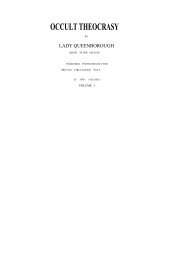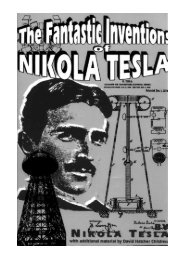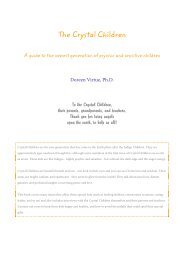the fantastic inventions of nikola tesla - Exopolitics Hong Kong
the fantastic inventions of nikola tesla - Exopolitics Hong Kong
the fantastic inventions of nikola tesla - Exopolitics Hong Kong
Create successful ePaper yourself
Turn your PDF publications into a flip-book with our unique Google optimized e-Paper software.
Fig 34. – TUBE WITH FILAMENT<br />
RENDERED INCADESCENT IN AN<br />
ELECTROSTATIC FIELD<br />
Fig. 35. – CROOKES’ EXPERIMENT IN<br />
ELECTROSTATIC FIELD<br />
There is little chance to perfect a gas burner; not, perhaps, because human ingenuity has been bent upon that<br />
problem for centuries without a radical departure having been made—though this argument is not devoid <strong>of</strong><br />
force— but because in a burner <strong>the</strong> higher vibrations can never be reached except by passing through all <strong>the</strong> low<br />
ones. For how is a flame produced unless by a fall <strong>of</strong> lifted weights.? Such process cannot be maintained without<br />
renewal, and renewal is repeated passing from low to high vibrations. One way only seems to be open to improve a<br />
burner, and that n by trying to reach higher degrees <strong>of</strong> incandescence. Higher incandescence is equivalent to a<br />
quicker vibration that means more light from <strong>the</strong> same material, and that again, means more economy. In this<br />
direction some improvements have been made, but <strong>the</strong> progress is hampered by many limitations. Discarding, <strong>the</strong>n,<br />
<strong>the</strong> burner, <strong>the</strong>re remain <strong>the</strong> three ways first mentioned, which are essentially electrical.<br />
Suppose <strong>the</strong> light <strong>of</strong> <strong>the</strong> immediate future to be a solid rendered incandescent by electricity. Would it not seem that<br />
it is better to employ a small button than a frail filament? From many considerations it certainly must be concluded<br />
that a button is capable <strong>of</strong> a higher economy, assuming, <strong>of</strong> course, <strong>the</strong> difficulties connected with <strong>the</strong> operation <strong>of</strong><br />
such a lamp to be effectively overcome. But to light such a lamp we require a high potential and to get this<br />
economically we must use high frequencies.<br />
Such considerations apply even more to <strong>the</strong> production <strong>of</strong> light by <strong>the</strong> incandescence <strong>of</strong> a gas, or by phosphorescence.<br />
In all cases we require high frequencies and high potentials. These thoughts occurred to me a long time ago.<br />
Incidentally we gain, by <strong>the</strong> use <strong>of</strong> very high frequencies, many advantages, such as a higher economy in <strong>the</strong> light<br />
production, <strong>the</strong> possibility <strong>of</strong> working with one lead, <strong>the</strong> possibility <strong>of</strong> doing away with <strong>the</strong> leading-in wire, etc.<br />
The question is, how far can we go with frequencies? Ordinary conductors rapidly lose <strong>the</strong> facility <strong>of</strong> transmitting<br />
electric impulses when <strong>the</strong> frequency is greatly increased. Assume <strong>the</strong> means for <strong>the</strong> production <strong>of</strong> impulses <strong>of</strong> very<br />
great frequency brought to <strong>the</strong> utmost perfection, every one will naturally ask how to transmit <strong>the</strong>m when <strong>the</strong><br />
necessity arises. In transmitting such impulses through conductors we must remember that we have to deal with<br />
pressure and flow, in <strong>the</strong> ordinary interpretation <strong>of</strong> <strong>the</strong>se terms. Let <strong>the</strong> pressure increase to an enormous value, and<br />
let <strong>the</strong> flow correspondingly diminish, <strong>the</strong>n such impulses—variations merely <strong>of</strong> pressure, as it were—can no doubt<br />
be transmitted through a wire even if <strong>the</strong>ir frequency be many hundreds <strong>of</strong> millions per second. It would, <strong>of</strong> course,<br />
be out <strong>of</strong> question to transmit such impulses through a wire immersed in a gaseous medium, even if <strong>the</strong> wire were<br />
provided with a thick and excellent insulation for most <strong>of</strong> <strong>the</strong> energy would be lost in molecular bombardment and<br />
consequent heating. The end <strong>of</strong> <strong>the</strong> wire connected to <strong>the</strong> source would be heated, and <strong>the</strong> remote end would<br />
receive but a trifling part <strong>of</strong> <strong>the</strong> energy supplied. The prime necessity, <strong>the</strong>n, if such electric impulses are to be used,<br />
is to find means to reduce as much as possible <strong>the</strong> dissipation.









